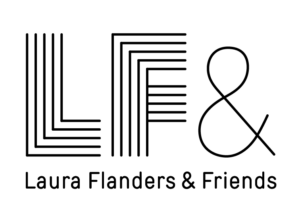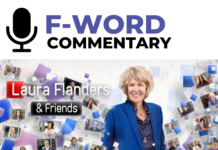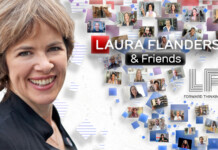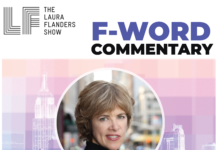To download, please subscribe. To download a single episode, click share in the podcast player below.
What are you watching? There’s a good chance it was edited by a woman. This time on the Laura Flanders Show, we talk with avant-garde filmmaker and cinema studies professor Su Friedrich about the hidden sheroes of film editing, the names you don’t know but ought to know from Hollywood to Bollywood and beyond. Aside from Blanche Sewell, the editor of The Wizard of Oz, and Thelma Schoonmaker, Martin Scorsese’s editor for over fifty years, there is Renu Saluja, who edited many classics of 1990s Indian cinema, and Mexico’s Gloria Schoemann, one of the most prolific editors in history with over 227 film credits to her name.
Friedrich is filling the gaps in global cinema history with an online archive called Edited By… which challenges the very notion of the solo cinema “auteur”. Without Viola Lawrence, for example, Orson Welles might never have made a successful film. While cinemas are closed for public health and new movie releases are on hold, Friedrich’s revealing conversation with Flanders—and her list of films edited by women —make for recommended viewing in these pandemic times.
“Editing, if it’s done well, is seamless. You don’t notice it.”
Guests:
- Su Friedrich, avant garde filmmaker and cinema studies professor
Transcript
Laura Flanders:
Who edited The Wizard of Oz, or 20 films for Werner Herzog? The answers might surprise you. This time I’ll talk with renown avant garde film director, Su Friedrich about the hidden female figures of the film industry, how they’ve changed film editing, Hollywood, and even the concept of solo authorship itself. Friedrich has just launched the first ever archive of women editors, and today she’s going to take us on a visual journey through a century of their work. Su Friedrich and a celebration of the hidden heroes behind the editing room door, next. This is The Laura Flanders Show, the place where the people who say it can’t be done take a back seat to the people who are doing it. Welcome.
Laura Flanders:
So, tell the surprise. Who edited The Wizard of Oz?
Su Friedrich:
Blanche Sewell.
Laura Flanders:
And who is Blanche Sewell?
Su Friedrich:
Blanch Sewell was one of the many editors who worked in the studio system in Hollywood in the ’30s and ’40s and on, before and after. She did many other films, but when I started to research this, I came across her and it was one of those moments where I thought, “I have never wondered who edited The Wizard of Oz.” I’ve seen it, we’ve all seen it. I’ve been a filmmaker forever, but never occurred to me that somebody might’ve edited and that it would be a woman. That blew my mind, and that became my mantra. The whole year or more that I was working on this, I kept thinking, “Who edited The Wizard of Oz?” Because it also became a question that led to all of the other questions you could ask about who edited every film you love, every film.
Laura Flanders:
So it’s not just who did it, being women as opposed to men, but that it happened all, that somebody is actually editing. Let’s get to that, but let’s back up with how women found themselves behind that editing room door, and who they were.
Su Friedrich:
Well, in the early days, people didn’t edit. They were just single real films. And then people started understanding what editing was, and it was a menial job. You had a short bit of film and you would sit in a room with a rewind and hold it up to the light, and cut things together. And so back then they thought, “Oh, women are really good with their hands. They’re good at sewing, and so we’ll make them do that. And we’ll not let them continue to be cinematographers and directors,” which women were in the early days. So they became stuck in this back room and they were called the cutters because they cut. Gradually film became more complicated, editing became more complicated, and it was the women who were doing it.
Su Friedrich:
At the point that sound came in, so 1929, we’re talking about the Hollywood system then, but cinema was going on all over the world. But anyway, at that point they thought, “Oh, sound is complicated. Maybe these ladies won’t be able to do it.” But all of the major studios in Hollywood, when they had their first sound film, they were all edited by women because women actually did figure out how to cut sound and picture together.
Laura Flanders:
Fancy that.
Su Friedrich:
There was a point at which Irving Thalberg, who was the head of one of the big studios, invented the term editor because of Viola Lawrence. So even the term that we now know was used for the first time because of what this woman was doing.
Laura Flanders:
And Viola Lawrence was?
Su Friedrich:
Oh, she was a major editor in Hollywood. She caught The Lady from Shanghai by Orson Welles. And also, there was a lot of back and forth between the editors and the producers and directors. And so Viola Lawrence is known for the fact that when she was trying to cut Lady from Shanghai, she couldn’t do it well enough because Welles hadn’t shot enough closeups. So she went to the producer and said, “You need to tell him he has to …” And you know these directors are like, “Oh, don’t tell me what to do.” But he actually had to do it so she could cut in these closeups. There are a lot of examples of that.
Laura Flanders:
But then we think of it as the film by Orson Welles.
Su Friedrich:
Right, yes.
Laura Flanders:
Which is a whole nother subject.
Su Friedrich:
It’s a whole nother subject.
Laura Flanders:
But we’ll get to it. You’ve moved quickly over, “I’ve been a filmmaker for many years.” You have been a filmmaker for many years. Talk us a little bit about how you got into this work, what you thought your journey was going to be and then, I don’t know, how it feels, what you think about coming upon this large body of undone work in the 21st century.
Su Friedrich:
Right. Well, I started making films in 1978, and I immediately did the editing as well as the shooting and writing and whatever, because to me that was a very exciting aspect to putting it together. I couldn’t imagine trying to explain to somebody else how to edit.
Laura Flanders:
Budget had nothing to do with it?
Su Friedrich:
I would say not at the beginning. And after a while, to me editing was so essential or central to the project that I wouldn’t have thought to hire an editor. The website is divided into two parts. So you have-
Laura Flanders:
This is the website you’ve created that ?
Su Friedrich:
Yes, the website. And so there are about 98 professional editors who are each on a page featured singly. Then there’s a section in the back called filmmakers who always or sometimes edit because as I was working on it, I thought, “Hold on a minute.” There is Bobby McLean or Renu Saluja or you name it, all these incredible editors. But there’s also a lot of people like me who do their own editing.
Su Friedrich:
So for me, at the point at which I started working on it, I was teaching. I teach film production. I was looking at a chapter of a book about editing to give to my students and I’m reading it along. They’re saying, “Oh, this fantastic thing that somebody developed, blah, blah blah.” And it only said the director. It said in North by Northwest, by Hitchcock, dah, dah, dah, dah. And I thought, “Well, why aren’t they mentioning the editor?” So I went through the entire chapter and looked up all the films to see who the editor was. And when I did, at least half of the films mentioned were edited by women.
Su Friedrich:
This is a chapter about good editing, right? So suddenly there’s The Wizard of Oz, Blanche Sewell. And I thought, “How do I not know about this?” And that was it. It was like from that day I thought everybody needs to know what happens when these films were made.
Laura Flanders:
Because you yourself are renowned, as I say, as well, feminist avant garde, LGBTQ, adventurous filmmaker, creating an irv that hadn’t existed before, both form and content, subject matter and form. And yet you’ve gone back into the traditional field to find it wasn’t so traditional after all. Or there were a bunch of interesting revolutionaries that have really changed cinema from inside.
Su Friedrich:
Yes, definitely. I think my own approach to filmmaking is different than theirs, and that’s part of the feeling of having the filmmakers who always or sometimes edit. But also, as I was reading about a new person, discovering somebody else, looking at footage from a film that they had edited, I thought, so this person is doing Bonnie and Clyde, Dede Allen, or a Buñuel film or you name it, but the basic work of it is the same. I may be editing disparate footage into something that somebody might call experimental. But getting a sense of rhythm, understanding how one image connects to the next, creating these unspoken relationships between things, it has to happen in a narrative Hollywood movie in the same way that it has to happen in an experimental film, in a documentary, in any film.
Su Friedrich:
When I was doing the pages, I first had just biographical information about each woman. And at some point I thought a part of the issue of editing is that it’s seamless. It’s invisible people. If it’s good, people don’t notice it and so they don’t talk about the editor. They talk about the director, or they’ll talk about the cinematographer, or they’ll talk about the writer. And I thought the way to start correcting that, aside from the website in general, is to get the words of the editors. And so that was another element that I added to each page. So you can hear each woman say, “Well, when I was working with Godard, when I was working with Herzog, when I was working with any of these others, this is the stuff that happened. These were the decisions I made, these were the changes I made, et cetera.”
Laura Flanders:
Fascinating. You’re talking about some of the most famous filmmakers in the 20th century and beyond. The story actually begins in the 19th century. Your website had so much on it. I’ve promised that you’re going to take us on a journey. So, where do you want to begin?
Su Friedrich:
Well, when I started making the website, I definitely wanted it to be very quiet. Websites are filled with links. You start reading an article, link, link, link, link, link, link. And I thought, this is a big, complicated topic. There are going to be lots of people in it, and I want people to experience it more like a book, and I want to have a sense of order to it. So I’m going to, for example, organize the editors by the date of birth. So you start with Hettie Gray Baker who began working in 1912, worked on some of the earliest John Ford movies, et cetera, and you end with Pamela Martin who did the Battle of the Sexes two or three years ago. And so you can travel through time.
Su Friedrich:
I also just within each page wanted it to be sufficient, but not overwhelming, so that you could go to see Adrienne Fazan. You could see a picture of her, then you could read about the fact that she was the main editor for Minnelli for many years. She won an Oscar for Gigi. Then you might see another picture, then see a few posters, so that was the next element. I thought, “Oh, people like visuals, so I’m going to find fantastic movie posters for films that each of them did.” And so on a page you can just have a sampling of that person, and then you can move to the next, the next, the next.
Su Friedrich:
And then it grew, so then I wanted to include some quotation from each of them. And then in the course of doing the research, I found out how impossible it was to get information. Because when I started, I typed in women film editors and Google came up with Thelma Schoonmaker, of course the editor of Scorsese forever, and maybe Dede Allen was on the first page. And then there was nothing. So in the case of each person, it was a tremendous amount of research. But once I found after digging and digging and digging a really good interview, whether a video interview or a text interview, then I thought, “Now, I’m going to make an appendix.” So I have a like 50-page appendix in the back, so that with each woman you can go to that and find really the best information.
Su Friedrich:
Aside from Blanche Sewell who edited The Wizard of Oz, there’s somebody like Gloria Schoemann. She edited 222 films and pretty much all of the films from the golden age of Mexican cinema in the 1940s and 1950s. A lot of the women did 85 films, however many films. Gloria Schoemann wins the prize for 222 films. So she was one remarkable example, after I had been already overwhelmed by so many other people.
Su Friedrich:
Then there’s Andrée Davanture. She’s French and she started a small company in Paris called Atria or Atria, but she was the editor of all of the great films that were coming out of Africa in the 1960s and 1970s. Any of the great African directors, multiple films by each of them. And so she had this studio in Paris and they would come and work with her in Paris. And a lot of them it was maybe their first film or their second film, and they spoke about how much they learned from her. They had shot very carefully and written very carefully, but then she was crafting these films. So she was also a great find.
Su Friedrich:
When I started researching, a lot of the films were Hollywood studio films and I recognized for my own interests and the world that that wasn’t the end of the story. And so I started looking out into the world. There are also Indian editors, Tunisian editors, Egyptian editors, Iranian editors, Polish, you name it. So you have somebody like Halina Prugar-Ketling who was the main editor of Andrzej Wajda, who when I was coming up as a filmmaker his movies were so important to me. And again, when I was-
Laura Flanders:
Out of Poland?
Su Friedrich:
Out of Poland. I was watching those films and not necessarily thinking about the editing because they were perfectly edited. So I was just engaged in the story, which is the point of good editing. And suddenly I discovered that it was a woman who was doing all those great films.
Laura Flanders:
Do you think it would’ve changed your experience of yourself and your own work at that moment if you’d known it?
Su Friedrich:
Well, that’s an interesting question. I don’t know. It probably would have made me feel good about women.
Laura Flanders:
You had more company than you knew.
Su Friedrich:
Also, because now of course, we have much more of an awareness about, let’s say, Hollywood and how terrible it’s been with women, and so there are more websites and conferences and discussions about there should be more women directors. There have been great women directors. More awareness, cinematographers. And so I think if 25 years ago I had made this website, people would’ve said, “Wow, there have been lots of women editors.” So I think it would have been good for the general public or for other filmmakers and also for me to know about it. But it took until now.
Laura Flanders:
Does the gendering of different roles and the appreciation that’s accorded to those different roles, and hence the different genders, is that consistent across the different countries that you looked at? Did the Italian celebrate their women editors more? Is it just us who haven’t celebrated them? India, the other countries you’ve mentioned?
Su Friedrich:
I think editing has always been a very invisible profession. And when I finished, when I launched the site at first, last January, I was in touch with ACE, the American Cinema Editors, because there are lots of women ACE editors who are on it, and they sent it out to their editors. One of the emails I got back was from Carol Littleton who edited ET, as well as many great films by Lawrence Kasdan. She wrote me and said, “Thank you so much. People just don’t think about this. They don’t recognize it.”
Su Friedrich:
The other thing, which is true universally is that when I started looking for the posters, I was mostly excited about them as a visual element and great designs and everything. And then you know at the bottom of posters all the small prints?
Laura Flanders:
The illegible part?
Su Friedrich:
The illegible part, which actually if you read it, you discover that it lists virtually everybody except the editor. It will list the composer and not the editor. So the more I worked, the more I thought this is so necessary. It’s so necessary for people to honor the work that made the film finally be the great film that it is.
Laura Flanders:
It’s interesting because I’m remembering when we first … well, not when we first met, we’ve known each other for many decades, but when we met recently and you were talking about this, I was thinking, “Well, how does it relate to the typical theme of one of our shows which is around shifting power in the worlds of arts, politics and economics?” And as I thought about it, I realized it has a lot to do with shifting power.
Su Friedrich:
Yes.
Laura Flanders:
Talk about it as you see it, and I’ll see if I have any additional thoughts to contribute.
Su Friedrich:
I think it makes a massive difference. When I first was working on it as a PowerPoint, I showed it to a friend who’s a film scholar and a feminist, a lesbian. She just said, “Su, this is going to change film scholarship.” I had no idea who any of these people were. I’ve heard that so often since, and I’ve heard so many teachers say I’m now using this in my classroom.
Su Friedrich:
This one woman who’s a filmmaker and an editor, Karen Pearlman, we were in touch a lot about various things. She knows a lot about Russian filmmakers and editors, and she said, “The standard in scholarship, the standard for talking about a film is you have the title and then in parentheses North by Northwest, Hitchcock, 1963 whenever it was made.” And she said, “I want from now on for it to say Hitchcock et al, because I want language to tell us all the time that it wasn’t just the director who made this movie.” And so the et al also applies to the cinematographer and the writer. But again, writers tend to be recognized, cinematographers tend to get recognized and editors don’t.
Laura Flanders:
And therefore, is serving to de individualize accomplishment, achievement?
Su Friedrich:
That’s right, that’s right.
Laura Flanders:
We love a hero story of pretty much anything.
Su Friedrich:
Right.
Laura Flanders:
In history, science, it’s always one person. They get one award. And at the Academy Awards, they’re up there fighting over who’s going to hold it. There was an Academy Award, I guess, for editing?
Su Friedrich:
There is, and it started in the 1940s. It came in later. A woman, Anne Bauchens, who worked for Cecil B. DeMille for 40 years, she was his editor, and she was nominated in the first go round of the best editing award. And around that time, men started thinking, “Oh wait. If you can get an award for this, maybe there’s more to it.” And they started coming in and saying, “What about me? Maybe I’m going to be an editor.” So yes, there is an award for everything. And the winner of the most Oscars for best editing is a woman, Thelma Schoonmaker. So there is an award.
Laura Flanders:
So to go back to the de-centering of this in universal hero, that seems like a story we tell a lot on this program, around actually it takes a collective effort, but for many years we’ve not been hearing much about collective effort in this country.
Su Friedrich:
Right.
Laura Flanders:
There is a gender aspect to it though too because it does seem to me that a lot of the work that women do, or that it is often gendered work, the work of pulling things together.
Su Friedrich:
Mm-hmm (affirmative).
Laura Flanders:
Helping this one make sense of that one. I’m telling a group story, including everyone at the table. Raising a bunch of kids, getting everything done at the same time. Having your mind on many things at once, and that’s all work that is typically pretty invisible.
Su Friedrich:
Right.
Laura Flanders:
So it’s hard to just put your finger on exactly what is this category of job that women tend to do and they tend to get very little credit for, or whoever does that work, but it is raising one other question. We’re talking, and we haven’t thought about that, we didn’t discuss this before, but we’re talking as a lot of people are transitioning to working virtually, and they’re going to be asked to suddenly host conversations on Zoom or Skype or Hangouts, or some other proprietary platform for teaching.
Su Friedrich:
Right.
Laura Flanders:
The skills required for that seem a little bit like the skills for editing and for thinking about how do you craft a story?
Su Friedrich:
Mm-hmm (affirmative).
Laura Flanders:
I’m just going to say it right now, that I think there’s a bunch of new skills that are going to need to be learned by a lot of people who think they’re already heroes and the best at their thing, and they might need to come to women to learn some of those skills.
Su Friedrich:
That’s right, that’s right. But it’s funny because a lot of people have asked me over this last two years about whether being an editor as a woman makes sense if you have a male director. So it presumes the classic setup. You’ve got the male director and you’ve got the woman editor. So it’s like the leader, the helper. There are some men who will talk about the fact that it’s a woman they’re working with that makes sense to them in that way, that women … how they understand women. But then you have to stand back and say, “Well, half the editors are men working for a male director.” So I think it’s not good to assume that the editor takes this, what we call, female role in relation to the director, because that can’t be how editing works. You have to be your own person.
Su Friedrich:
You have to have your own ideas about how the thing should be done. You have to be forceful and persuasive, whether you’re working with a male or female director. You take somebody like Walter Murch who is the most well known, famous, vocal male editor. He’s a great editor. Nobody looks at him and says, “Well, how does it feel to be in the helper position?” They don’t. They say, “How does it feel to be a really great editor? How do you do it?” And so I think we have to accord the same respect to any woman who is contending with the ego of whoever it might be.
Laura Flanders:
No, that makes a much better point than what I just made. Editing per se, it seems to me tells the story. Directing, there’s somebody that does it all. Could you say that an editor could save a bad film, but a director couldn’t save a bad edit, or something like that?
Su Friedrich:
An editor would be hard pressed to save a bad film because if the director hasn’t done their job and the writer hasn’t done their job, you can only do so much. And then you just can’t do more because if they haven’t gotten the shots right, you don’t have continuity. You don’t have the things that make sense. You can try, but you know. But they’ve tried, they’ve had to try a lot. But there is a quote from somebody about the editing begins at the writing stage and the writing ends at the editing stage.
Su Friedrich:
It’s like if you’re a good writer, you’re already anticipating what the editing will be. And if you’re a good editor, you’re kind of rewriting the script because you have to make a lot of decisions about what doesn’t work at that point. You’ve got the script and then you can say, “Well, you don’t have the shots. It doesn’t flow, it makes no sense anymore and you’ve got to get rid of that stuff.” As the editor, that’s your responsibility.
Laura Flanders:
So there are 206 editors on this site. Do you have a favorite? Do you have somebody who lives on your shoulder as you’re working or teaching? All right, a couple.
Su Friedrich:
No fair.
Laura Flanders:
We’re talking collective. We’re talking collective. going to research one?
Su Friedrich:
I love Blanche Sewell for doing The Wizard of Oz, but maybe that’s getting silly. But somebody like Dede Allen is due endless respect for the work she did and the inventions that she made in the course of being an editor. Nobody has asked me that question before.
Laura Flanders:
It’s a creepy question, I guess.
Su Friedrich:
It’s not creepy, it’s not creepy. It’s like people ask me, who’s my favorite filmmaker as a filmmaker? I would just say I really love all of them. And when I was working on this, I felt like I’m with my people. I know what that feels like to be in the editing room and fighting with that material to get it to work. And when I would look at a new person’s work and think about what they had done, when you see the clips …
Su Friedrich:
I have this two hour film on the website where you go chronologically by when the film was made, and you see a more or less one minute clip from one of the films that that woman edited. And you watch from 1926 to Battle of the Sexes and you just see the phenomenal creativity.
Su Friedrich:
Lyudmila Feiginova did all of Tarkovsky’s films. Very slow editing. So you see something like that and then you see Bonnie and Clyde by Dede Allen, and you just see different paces, where people bring in humor. Just endless creativity.
Laura Flanders:
The website address is? Where do people go if they want to find this marvelous archive?
Su Friedrich:
Well, the URL is womenfilmeditors.princeton.edu, and that’s because Princeton where I teach agreed to host the site and I’m very grateful for that. But the thing is if you go to Google and you type in Women Film Editors, it’s like the second thing. Or the site itself is called Edited by, but it’s really easy to find. It’s on the first page of Google, and it got onto the first page of Google within a week of the launch because people were just …
Laura Flanders:
That tells you something. Yay, Princeton.
Su Friedrich:
And what I discovered is also that when you put in Jolanda Benvenuti for example, who did most of Rossellini’s films, who did not get credit for Rome, Open City onscreen, did not get onscreen credit for Rome, Open City, which is considered one of the most important films, now you type in her name and she shows up on the first page on my site. So all of these editors now you can find really quickly when you Google them. And that’s part of the point.
Laura Flanders:
Perfect. Su Friedrich, thank you so much. You can find more information at the aforementioned site and at ours. Thanks for checking out the program.
















